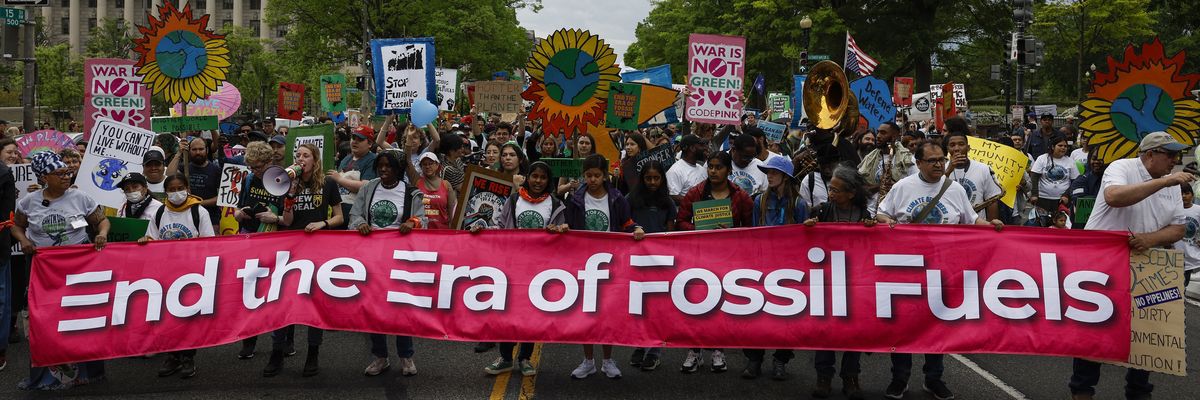The following is part of a series of opinion pieces Common Dreams is publishing in the lead-up to the March to End Fossil Fuels on Sunday, September 17 in New York City. Read the rest of the series and our complete coverage here.
It had never struck me until recently how many environmental activist groups there are. Within the U.S. alone, there are around 28,000 different environmental groups currently operating, from small grassroots organizations to giants of the climate movement like 350.org, Greenpeace, and Sunrise. Among these groups, there is also a huge array of sometimes conflicting opinions that reflect the sense of uncertainty that often goes hand in hand with the fight against climate change.
As someone who would consider himself an environmentalist, the sheer amount of people, groups, and perspectives that circulate around the matter of climate change can make it feel like I am not part of a movement with a coherent goal, but rather a highly competitive sector of an “activism industry.” As climate change bears down upon us, the environmental movement needs to fight as one. People uniting as one to drive world leaders forward is essential to stopping climate change; it is also what makes the March to End Fossil Fuels special.
Anybody who follows a climate-related Instagram account probably knows that today, September 17, the March to End Fossil Fuels is taking place in the middle of New York City in order to persuade the Biden Administration and the U.N. to initiate phaseout plans for fossil fuels. This is for good reason; the event is the biggest climate protest that has occurred since the pandemic, with a turnout goal of over 50,000 people.
When the decision-making power required to save the planet from climate change lies in the hands of very few people, the only way forward is with the strength of overwhelming numbers.
The protest is an impressive display of unity within the climate movement when taken in a vacuum. It was organized as a joint effort by a variety of New York grassroots organizations as well as larger U.S.-based coalitions such as People vs. Fossil Fuels. The planning team for the march spans generations and regions, drawing in all manner of people. What is perhaps more impressive is that the actions taking place during the week of the march are not limited to New York alone. There will be over 400 different actions taking place around the same few days across the world. This push to end the reign of fossil fuels has allowed the climate movement to act as one giant machine in a burst of collective action.
I became involved in environmental causes because I wanted to be a part of something greater than myself. Frightened by the future that might come to pass if climate change ran its course, I started joining climate lobbying groups when I started high school in the hopes that I would be helping bring a larger movement forward. In the time since then, I haven’t necessarily found this to be the case. In fact, I have noticed that there is a surprising amount of discord between climate advocacy groups, to the extent that people often refuse potentially advantageous collaboration on the basis of minor differences in opinion or specialization. I find that the refusal of many environmentalists to work with people who do not share their exact beliefs to run contrary to the need for collaboration that is so necessary to stop the climate crisis. As such, I am overjoyed to see people coming together on a scale like that of the march in order to fight the fossil fuel industry.
The climate movement has been shaped by the sluggishness and weakness of world leaders in responding to its concerns. When the decision-making power required to save the planet from climate change lies in the hands of very few people, the only way forward is with the strength of overwhelming numbers. This is not something that the climate movement can achieve as a group of independent actors; to stop climate change, everyone must move together as they are doing now.
The necessity of collective action in relation to climate change does not stop when the March to End Fossil Fuels and its companion actions end. In the aftermath of the event, there will inevitably be considerable momentum left over; people will be angrier than ever at how world leaders and global capitalism aid and abet the destruction of the planet. My hope for the activist community surrounding climate change is that this momentum is used to keep people together to push for newer, bolder action. Coalitions like the one that planned the March to End Fossil Fuels are powerful political tools that could potentially be used to even greater effect in relation to specific issues such as climate education, regenerative agriculture, or corporate accountability.
Climate change has many facets, all of which need to be brought into the light for the crisis to be solved. The climate movement has proven on many occasions that it has the ability to unify around a cause, and, as the climate crisis gets worse and worse, it must continue to do so. The March to End Fossil Fuels is a call for people to unite against the biggest threat to our planet that we as a species have faced, and it is one that I suggest we all answer.



